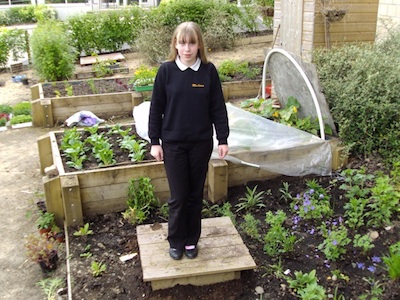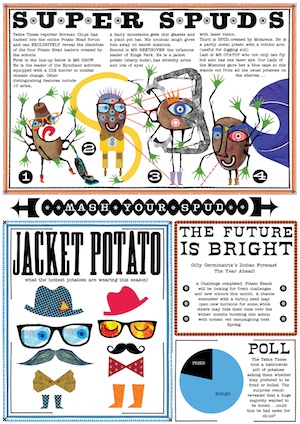ABOUT
Environmental art organisation NVA worked with P7 – S5 pupils from Glasgow, Dundee, Stirling and East Renfrewshire schools to explore the cultural, social, ethical and political aspects of food production and growing food locally. The Potato Heads project gave pupils creative opportunities to explore and articulate desires for environmental change and a greener, more sustainable future.
Pupils from each participating school were invited to join The Potato Heads, a group of green activists, and asked to design their own fictional leader and write a manifesto for change. They took part in a series of workshops and online activities, and were given a plant to take care of throughout the summer holidays, and to grow potatoes for Glasgow Harvest as part of the Double Rubble Chip Challenge.
Click here to watch 5 minute video
The project connected to NVA’s wider community project SAGE (sow and grow everywhere™) and involved a collaboration with digital design studio ISO.
The project involved:
- NVA
- 19 pupils (S1) from a Glasgow secondary school
- 6 pupils (S5) with additional support needs from a Dundee secondary school
- 32 pupils (P7) from an East Renfrewshire primary school
- 7 pupils (P7) from a Stirling primary school
Partners:
- Central Station
- ISO digital design studio
- East Renfrewshire, Dundee, Glasgow and Stirling local authorities
PURPOSE
The project aimed to:
- Start pupils growing their own food – each pupil was given one plant of their own to take care of throughout the summer. They were also given potatoes to grow collectively for Glasgow Harvest 28.08.10.
- Engage pupils in thinking about how they could lead social change – in this instance towards a greener, more sustainable future.
CURRICULUM AREAS
- Expressive Arts
- Health and Wellbeing
- Languages
- Mathematics
- Social Studies
- Science
LEVELS AND STAGES
P7 – S5
TYPES OF LEARNING
The project included a lot of group work and active learning, was ‘hands-on’, and empowered young people to take control of their own learning, enabling them to try things out for themselves, think for themselves, becoming more aware of their responsibilities and putting forward their own ideas/suggestions.
PROJECT ACTIVITY
Participants communicated with other schools, learned about Glasgow Harvest, and contributed to the community. At each school a live workshop was hosted every four weeks, including a Glow Meet with one of the other schools involved if possible. Outside of the workshops, schools engaged with the project via the Potato Heads Glow group where NVA posted short podcasts and instruction sheets for the schools to access online.
The inspiration for ’The Potato Heads’ project was a Mexican group of revolutionaries called the Zapatistas (a socialist revolutionary movement, mainly active in Mexico) who use the internet and art as their chief method of publicising their work. Rather than protesting and marches, the Zapatistas use humour, art and the internet to spread their message for social change. NVA adopted a similarly creative process with participants in the project, as they used art to provoke collective action.
The Learning Programme was based around the concept that all the pupils were part of a group of green activists called ‘The Potato Heads’. They were each headed up by a fictional leader designed by themselves (the leaders were given names, characteristics and superpowers). Pupils explored the concept of change and how to effect change, and the role of activists. They also explored alternative approaches used by artists such as Banksy. Nick Mellville, an Edinburgh based poet, led some workshops about poetry, linking to slogans about what the pupils wanted to change, and how they could communicate these desires succinctly and engagingly. The pupils also carried out research into reducing fuel emissions and the benefits of growing food locally.
All pupils were invited to the culmination of the project at NVA’s Glasgow Harvest event at Tramway in Glasgow on the Saturday 28th August 2010. At this celebration of urban growing, the pupils were invited to cook their potatoes as part of the ‘Double Rubble Chip Challenge Competition’.
How was Glow used?
Glow was used to post a series of tasks for teachers to download and complete with their class. Glow Meets were held between participating schools. Pupils used the Glow group to communicate with each other and their teachers/project leaders regarding their growing tasks, to discuss climate change and to post their own work.
IMPACTS
An independent evaluation was carried out by Blake Stevenson. Their research shows that the project had the following impacts:
New skills, knowledge and approaches for teachers
- Knowledge of and enthusiasm for Glow
- Recognition of pupils’ interest in growing and environmental/green issues – resulting in plans to repeat the project and develop a sensory garden in one school.
- Hands on learning/teaching methods had been successful
- Benefits of working with a partner arts organisation who used creative, hands on, interdisciplinary approaches
New skills, knowledge and experiences for pupils
The project promoted the following key learning:
- an understanding of how to grow and cook food;
- more knowledge of food and food production, climate change and globalisation;
- understanding of social action, change and taking control;
- working together and teaching other young people;
- poetry, drawing and photography;
- using Glow;
- participating in the Glasgow Harvest Event at Glasgow’s Hidden Gardens
The project supported pupils to achieve progress in the following ways:
Successful Learners – during the work of the project pupils became enthusiastic and motivated learners and became open to new thinking and ideas. Pupils became better at communicating, thinking creatively and independently, linking and applying different kinds of learning in new situations, learning independently and as a group and using technology for learning.
Responsible Citizens – as a result of the project pupils became more respectful of others and committed to participate responsibly in political and social life. Pupils developed understanding of the world, became more aware of others beliefs and cultures, more able to evaluate environmental and scientific issues, and informed and ethical views of complex issues.
Confident Individuals – the project increased pupils’ self-respect, and helped them to have more secure values and beliefs. Pupils became better able to relate to others and manage themselves, pursue a healthy and active lifestyle, be self-aware and develop and communicate their own beliefs and view of the world.
Effective Contributors – the project supported pupils to work in partnership and in teams and also to become more self-reliant. Pupils had the opportunity to take the initiative and lead, communicate in different ways and in different settings, apply critical thinking in new contexts and create and develop.
New skills and knowledge for NVA
The main lesson that NVA took from the project was that they need to be more open minded about adapting materials to suit the level of different pupils involved in a project.
NVA learned the importance of allowing sufficient tiem for planning and consultation at the start of the process.
NVA felt there was a lack of buy-in from teachers in-between the workshops they delivered, and that teachers viewed NVA as deliverers, rather than it being an exchange between teachers and arts professionals. NVA felt it would have worked better if there was more collaboration.
NVA learned that they need to be clearer with teachers about what involvement/time-input is expected of them at the planning stage of the project.
NVA developed new relationships with ISO, Central Station and the Hidden Gardens which they felt would benefit future projects.
CHALLENGES
NVA had originally intended to work with Glasgow schools due to the geographical reach of the Glasgow Harvest event, but the authority had not yet carried out full Glow rollout, so schools were selected from several other authorities.
The project was the first time that most of the teachers involved had used Glow. Some felt that the training they had received was not very comprehensive and several of them experienced technical problems when they tried to use Glow.
NVA had expected Glow to be more intuitive both for uploading resources, and social networking, and said that they and participants spent more time becoming familiar with Glow than they had envisaged.
Not all participating schools were able to use Glow Meet.
There was some difficulty in terms of communication with teachers, who could be difficult to contact due to their teaching schedules.
KEY LEARNING
The impact of the project was positive, and Glow was particularly useful in bringing people from different geographic locations together. However, in retrospect, NVA feel it would have been better to ‘twin’ schools as opposed to ‘group’ schools together as the communication lines could have perhaps been more focused for the pupils – i.e. each school working with one other school, instead of three schools each.
Other lessons included:
- pupils enjoyed the project, were really enthusiastic about growing food and liked using Glow;
- teachers needed to schedule time during the week to work on the Glow site independently of the Glow Meets or live workshops;
- it would have been preferable to have a training session for teachers before a Glow programme started for them to take ownership of the programme and integrate it into the curriculum;
- pupils would have benefited from being given email ‘cluster’ groups within their class to link to other ‘clusters’ in the other schools- this would have allowed them to work on tasks together and take away the anonymity of their connections
OUTCOMES
One of the primary schools said that the main legacy for them would be having a better idea of how to use Glow, and that they had got to know their pupils better. They also said they intended to repeat the Potato Heads project next year with a new class, and have developed a sensory garden as a result of the children’s interest in growing and nature. It appears that the project has really expanded out to other classes and pupils in the school. Some of the pupils have also been teaching their younger peers about how to grow potatoes, and the school have expanded the theme of ‘growing’ to school-wide activities. They have also discussed the possibility of connecting with a school abroad.
Staff at all of the participating schools said that the project would increase their use of Glow, as their pupils had really enjoyed using it during the project – they had seen that it was a great resource for teaching purposes.
Pupils agreed that Glow was interesting, fun and easy to use, that there was nothing they disliked about it and that they would like to use it more in future.
FUNDING
Co-Create was funded through a partnership between Learning and Teaching Scotland and Creative Scotland’s National Lottery Fund.
For more information contact:
Nichola Godsal, NVA, Godsal@nva.org.uk
Or visit:












